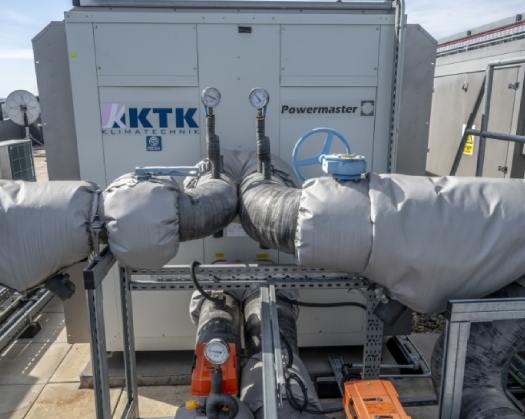Visitors leisurely meandering along the banks of the River Thames, situated in the heart of London, will soon find themselves in gratitude for the bustling construction site that now occupies their path.
As the project approaches its anticipated completion within the forthcoming years, the Bankside Yards development, which encompasses a mix of retail spaces, offices, and 600 residential units, is set to inaugurate new public areas and facilitate a more seamless pedestrian experience between notable attractions such as the Tate Modern and the Royal Festival Hall.
Daniel Moore, an architect and the technical director of the project for PLP Architecture, described the development as a "missing link" within the cultural landscape along the river, transforming a vast, inaccessible urban block into an integral part of the cultural sequence of spaces.
However, the 5.5-acre site, projected to cost 2.5 billion British pounds (approximately $3.3 billion), holds a significance beyond its role in enhancing a picturesque pathway.
Within the complex, which spans eight buildings, lies a pioneering energy system that raises critical questions regarding the rate of decarbonization not only in the United Kingdom but globally.
Bankside Yards is implementing a "fifth-generation" combined heating and cooling network designed to balance energy within individual buildings and then between them by redistributing excess heat, for instance, from a refrigerator in a restaurant or a piece of office equipment requiring cooling, to areas in need of hot water or domestic heating.
Electric-powered heat pumps installed on the rooftops of buildings and within each residential or commercial unit adjust the temperature of the water by either extracting or injecting heat into the pipes to provide the necessary heating, cooling, and hot water for each space.
"One unit may be expelling heat due to air conditioning, while another is in the process of showering and requires hot water," explained Daniel Moore.
Marco Wirtz, a German engineer specializing in fifth-generation systems, noted that by integrating buildings of various use types, the Bankside Yards project significantly improves the efficiency of its network, marking it as one of the largest and most innovative implementations of fifth-generation technology globally.
The energy system at Bankside Yards not only diminishes the energy required for heating, cooling, and supplying hot water within the complex but operates without the use of fossil fuels, thereby serving as a crucial instrument in the endeavor to achieve net-zero carbon emissions.
Dr. Jan Rosenow, the European program director of the Regulatory Assistance Project, an energy policy non-governmental organization, poses the critical question of why similar systems are not being implemented at a rapid and widespread scale. This is particularly pertinent given that the heating of homes accounts for nearly one-fifth of all greenhouse gas emissions in the United Kingdom.
Rosenow contends that the capacity to significantly reduce the energy demands of Bankside Yards and power them entirely with renewable electricity underscores the existence of solutions for emission reduction, yet their application is not being pursued with the requisite urgency.
"It's no longer a matter of technological limitations; rather, the social, political, and cultural dimensions play a more significant role in determining the pace of implementation," he stated.
Nicholas Gray, the sales and marketing director for the project's developer, Native Land, suggests that a shift in social attitudes, particularly towards cleaner buildings, may be occurring. This is in response to the growing demand from office tenants and residential buyers for properties that offer cleaner environments.
The first building in the complex, an 19-story office tower named Arbor, was completed in 2023 and has already secured over 75% of its rental or offer agreements, including from the environmental consultancy, the Carbon Trust.
This system represents the latest iteration of district heating, a concept that was commercially introduced in the United States in the 1870s. It involves heating buildings through a shared network of pipes, rather than relying on individual boilers or stoves.
Initially, this system utilized a central furnace to distribute steam at temperatures up to 390 degrees Fahrenheit, which has since evolved to use extremely hot water, with subsequent generations of district heating systems reducing the temperatures to minimize heat loss from the pipes.
The elevated temperatures are the primary reason behind the overheating of corridors and lobbies within numerous existing buildings, leading to a typical energy loss of 20% to 40% of the energy produced. Giovanni Festa, a project director at Sweco, a Swedish-based engineering consultancy, who was responsible for the design of the energy system at Bankside Yards, highlighted this issue.
Additionally, a fifth-generation network, also referred to as an ambient loop, is characterized by the water in its pipes being close to the ambient outside temperature. At Bankside Yards, the water temperature is maintained below 77 degrees Fahrenheit. The management of the complex has secured agreements with renewable electricity providers for the apartment heat pumps, which are compact in size and concealed within soundproofed cupboards.
Festa noted that the energy demands of the Arbor building have been significantly reduced through the use of high-quality window glazing and innovative design, resulting in a 30% decrease in energy consumption compared to current best practices.
Upon the completion of Bankside Yards in 2029, facility managers will conduct a review of performance data to enhance the efficiency of the system and utilize weather forecasts to further optimize its performance.
Festa believes that the Arbor building is at least two to three years ahead of its competitors, as other buildings currently under construction still rely on gas-fired systems.
A similar large-scale ambient loop system is in the process of being constructed at the 1,600-apartment Silvertown development in East London. However, the number of such projects remains relatively small, almost a decade after the term "fifth generation" was first introduced by researchers from the European Union.
A study on district heating systems by Cardiff University’s School of Engineering identified 74 fifth-generation networks in Germany, 16 in Switzerland, and smaller numbers in other countries, including three in China.
The Whisper Valley residential complex in Austin, Texas, is one of the largest projects in the United States to utilize an ambient loop system and heat pumps, with plans to accommodate 7,500 homes.
The British government estimates that approximately 20% of the country's buildings could benefit from district heating. However, experts in heating technology have observed a lack of government initiatives to promote the latest solutions in both new construction and retrofits, as well as in government-owned buildings.
Jamie Osborn, a spokesperson for the MCS Foundation, a British charity dedicated to promoting decarbonization, points out the barriers to a more rapid deployment of these systems, including the need for planning reform and increased public awareness.
While the expenses associated with each project may vary, Festa indicated that the installation of a fifth-generation system could be slightly more costly than an older gas-based system. However, he emphasized that the additional investment would be offset by the energy savings achieved. Furthermore, the system's emission-free nature eliminates the need for retrofitting, as it complies with the minimum carbon standards as they are reduced.
According to data from the European Heat Pump Association, there was a significant increase in the sales of heat pumps in the United Kingdom in 2023, with 60,000 units sold, a notable increase from the 720,000 sold in France, despite the latter having a slightly larger population. This surge in sales in the UK has contributed to a reduction in heating emissions by over 10 times the rate observed in France.
Thomas Nowak, who previously served as the secretary-general of the association and is now an executive at Qvantum, a company that promotes ambient loop systems, believes that such systems are essential for the heart of every city. However, he highlighted that the lack of awareness among policymakers and the general public has been a significant barrier to their widespread adoption.
Nowak pointed out that the perception that heating is a task best handled by individuals is not unique to the United Kingdom. He cited the example of the German government's challenges in implementing heating reforms last year, indicating that this mindset may stem from a historical perspective where individual responsibility for heating was the norm. Nowak argued that there is a shift towards more collaborative solutions that benefit the entire integrated system, thereby enhancing efficiency for all.













